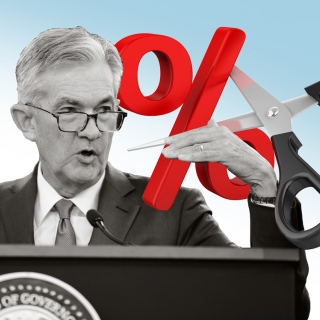


Federal Reserve Governor Christopher Waller said on Thursday he favors another interest rate cut at the U.S. central bank's policy meeting later this month because of worrisome labor market developments, while a colleague again made the case for an even more aggressive path of cuts.
"Based on all of the data we have on the labor market, I believe that the (Fed's policy committee) should reduce the policy rate another 25 basis points" at the end of October, Waller said in a speech given to a Council on Foreign Relations gathering in New York.
What comes after that meeting, Waller said, depends on future data. He said as he weighs whether more rate cuts are needed, "I will be looking for how the solid GDP data reconcile with the softening labor market." Waller reiterated his view that trade tariffs are having a modest impact on inflation and that price pressures remain on track to hit the Fed's 2% target. That outlook allows the central bank to focus policy deliberations on the job market, where there have been "some clear warning signs."
"The broad message of all the labor market data is one of weakening in demand, relative to supply, even with substantially lower net immigration and a decline in labor force participation this year," Waller said. He added as the Fed navigates this month's meeting without major data due to the U.S. government shutdown, private data are sending mixed signals about the state of hiring.
Waller explained that any signs of a pick-up in the job market amid strong growth could slow the need for rate cuts. But if hiring sputters and inflation remains in check, "I believe the FOMC (Federal Open Market Committee) should proceed to reduce the policy rate toward a neutral level, which I judge is about 100 to 125 basis points lower than it is today," implying a policy rate in the 2.75%-3.00% range.
Meawwhile, speaking in Washington, the Fed's newest governor, Stephen Miran, who is unusually on leave from the Trump White House while working at the central bank, again made his case for a more aggressive rate cut path than the one favored by his colleagues for 2025. He continued to argue that broader policy changes, including immigration shifts which he believes will lower inflation, give the central bank ample space to lower short-term borrowing costs, while adding renewed trade tension between the U.S. and China also call for action.
"I had been thinking the U.S. economy is in a pretty good place; I still think it's in a pretty decent place, however there's new risks that didn't exist a week ago. One substantial risk is that in my opinion, monetary policy is too tight, it's too restrictive," Miran said. "The longer it stays that restrictive, the greater the downside risk, both from the policy itself and also the greater brittleness and susceptibility to the types of shocks like we just have potentially reintroduced in the last week."
Source: Investing.com
The FOMC is expected to cut interest rates by 25 basis points with potential dissent, reflecting the tension between inflation risks and weakening employment. Federal Reserve Chairman Jerome Powell i...
National Economic Council Director Kevin Hassett stated that the Federal Reserve should cut interest rates at its upcoming meeting next week and predicted a reduction of 25 basis points. In an interv...
The Federal Reserve is expected to reduce interest rates by 25 basis points to a range of 3.5%-3.75% at next week's meeting, but Bank of America says Chair Jerome Powell faces the most divided committ...
Treasury Secretary Scott Bessent said Wednesday he will push for a new rule requiring regional Federal Reserve chairpersons to live in their district for at least three years. The initiative is Besse...
Inflation in the United States continues to show signs of moderation. The latest data shows CPI inflation hovering around 3% annually, while PCE inflation the Federal Reserve's favorite indicator is h...
US stocks closed higher on Friday (December 5), with the S&P 500 up 0.2%, the Nasdaq up 0.4%, and the Dow Jones Industrial Average up 0.2% as weak PCE data and positive sentiment in Michigan strengthened the likelihood of a 25bps Fed rate cut...
Oil prices edged up nearly 1% to a two-week high on Friday (December 5th) amid growing expectations that the US Federal Reserve will cut interest rates next week, which could boost economic growth and energy demand, as well as geopolitical...
Gold closed around $4,210 an ounce on Friday, near its highest level since late October, paring an earlier rally as a series of US data strengthened the case for an imminent Fed rate cut. Delayed September PCE rose 0.3% month-on-month and 2.8%...
 Asia Pacific stock markets opened quietly on Wednesday morning, with investors awaiting the release of key economic data from the United States and...
Asia Pacific stock markets opened quietly on Wednesday morning, with investors awaiting the release of key economic data from the United States and...
 Private businesses in the US cut 32K jobs in November 2025, following an upwardly revised 47K gain in October, and compared to forecasts of a 10K...
Private businesses in the US cut 32K jobs in November 2025, following an upwardly revised 47K gain in October, and compared to forecasts of a 10K...
 European stocks closed higher on Thursday (December 2nd), supported by a rebound in shares of major banks and automakers. The Eurozone STOXX 50 and...
European stocks closed higher on Thursday (December 2nd), supported by a rebound in shares of major banks and automakers. The Eurozone STOXX 50 and...
 A five-hour meeting between Russian President Vladimir Putin and Donald Trump's special envoy, Steve Witkoff, and his son-in-law Jared Kushner, in...
A five-hour meeting between Russian President Vladimir Putin and Donald Trump's special envoy, Steve Witkoff, and his son-in-law Jared Kushner, in...